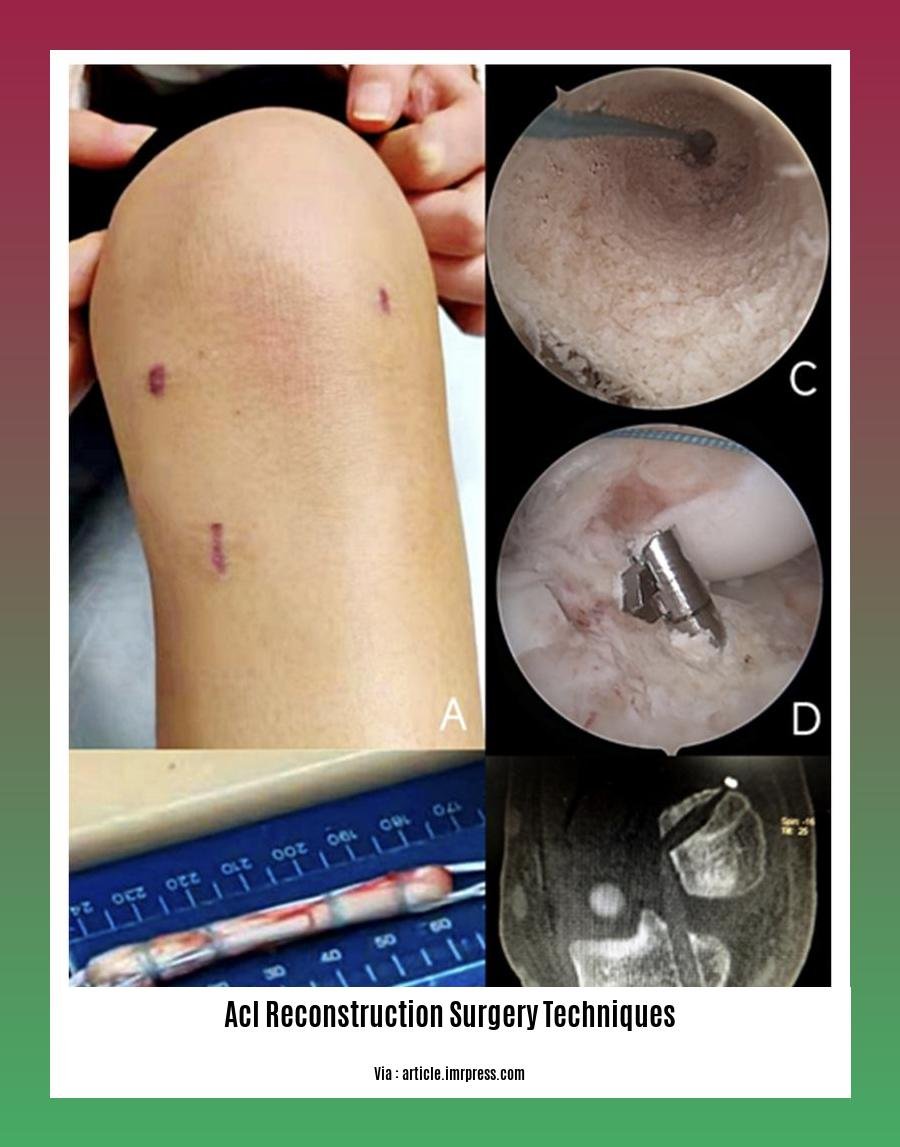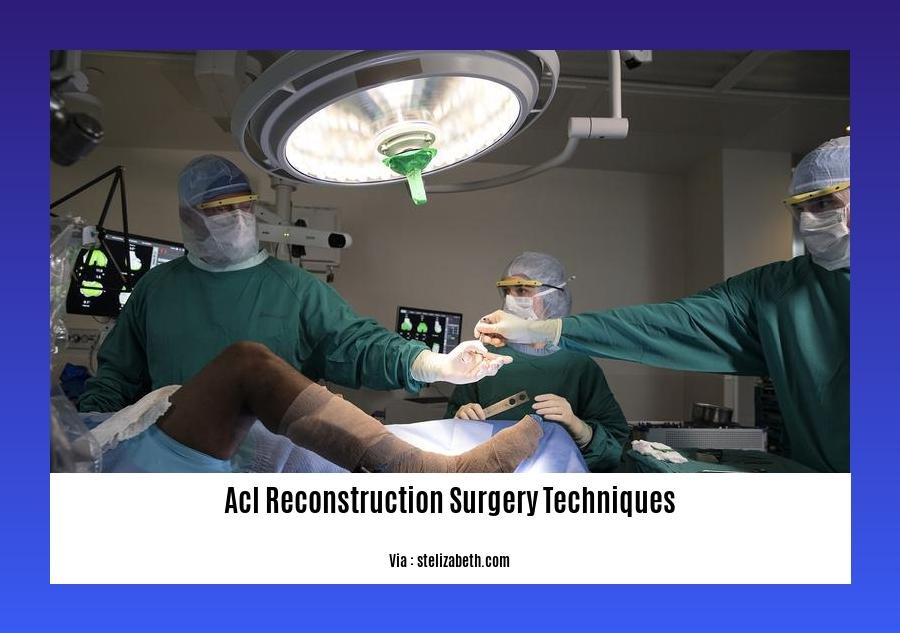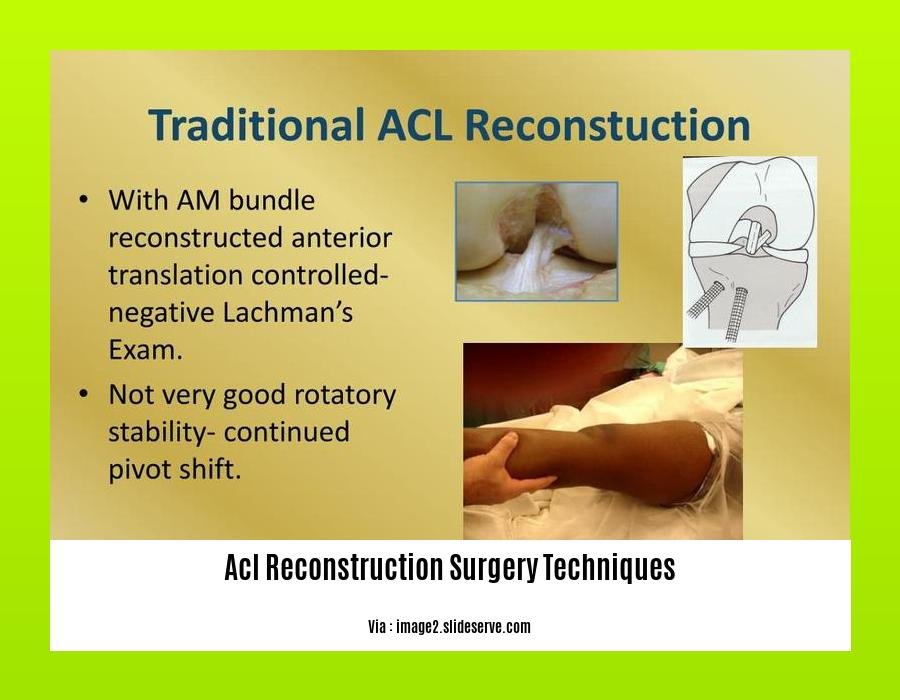ACL reconstruction surgery techniques are highly specialized procedures, designed to repair or replace a torn anterior cruciate ligament (ACL) in the knee. This guide explores the indications for ACL reconstruction, advantages of various techniques, and outcomes associated with these procedures, providing comprehensive information for patients considering this surgery.
Key Takeaways:
- ACL reconstruction aims to restore knee stability and function.
- Extra-articular and intra-articular techniques are used in the surgery.
- Understanding the knee anatomy is crucial for successful reconstruction.
- Autografts or allografts can be used as graft material.
- Recovery involves gradual rehabilitation exercises and activities.
ACL Reconstruction Surgery Techniques

When an ACL (anterior cruciate ligament) is torn, surgical reconstruction is often necessary to restore knee stability and mobility. There are two main ACL reconstruction surgery techniques:
-
Extra-articular Reconstruction (EA): The graft is placed around the outside of the knee joint, attaching to the tibia (shinbone) and femur (thighbone). This technique is less invasive, with less risk of knee stiffness.
-
Intra-articular Reconstruction (IA): The graft is passed through tunnels drilled through the tibia and femur, creating a new ACL ligament. This technique is more complex, but it provides greater stability and a more “natural” knee feel.
Each technique has advantages and disadvantages. Your surgeon will recommend the best technique for your individual needs.
Steps in ACL Reconstruction Surgery:
- Graft Preparation: A graft (tissue used to replace the torn ACL) is taken from either your own body (autograft) or from a donor (allograft).
- Tunnel Creation: Holes are drilled into the tibia and femur to pass the graft through.
- Graft Placement: The graft is passed through the tunnels and secured in place with screws or other fixation devices.
- Closure: The incisions are closed and a knee brace is applied.
Recovery:
After surgery, you will need to follow a rehabilitation program to regain knee mobility and strength. Recovery time varies depending on the technique used and your individual progress.
Risks and Complications:
As with any surgery, there are some risks associated with ACL reconstruction surgery techniques:
- Infection
- Bleeding
- Blood Clots
- Nerve damage
- Stiffness
- Failure of the graft
Talk to your surgeon about the specific risks and benefits of the ACL reconstruction surgery techniques before making a decision about your treatment.
Check out our comprehensive acl reconstruction rehab protocol to get back on your feet faster and stronger after surgery.
If you’re considering acl reconstruction surgery, learn about the costs involved and how to make the decision that’s right for you.
For a detailed overview of acl reconstruction rehabilitation exercises, look no further than our expert guide.
Considering acl reconstruction surgery cost in india? Get all the information you need to make an informed choice.
Double-Bundle ACL Reconstruction
Double-Bundle ACL Reconstruction:
Double-bundle ACL reconstruction is a surgical technique designed to replicate the native anatomy and function of the anterior cruciate ligament (ACL). This advanced technique utilizes two distinct bundles to reconstruct the ACL, mimicking the anteromedial and posterolateral bundles found in the natural knee joint.
Key Benefits:
- Improved stability: Double-bundle reconstruction enhances knee stability, providing better support and protection during physical activities.
- Natural knee feel: By restoring the two distinct bundles, this technique recreates the natural knee kinematics, resulting in a more fluid and comfortable movement.
- Reduced risk of failure: The double-bundle approach reduces the risk of graft failure compared to single-bundle reconstruction.
Procedure Overview:
- Graft harvesting: The graft is typically harvested from a portion of the patient’s own hamstring or patellar tendon, or a donor tissue (allograft) is used.
- Tunnel creation: Two bone tunnels are drilled in the knee joint to accommodate the two bundles of the graft.
- Graft placement: The harvested graft is passed through the tunnels and secured into place using screws or buttons.
- Closure and immobilization: The surgery is completed by closing the incisions and placing the knee in a brace or cast for immobilization.
Recovery and Rehabilitation:
Recovery time for double-bundle ACL reconstruction varies depending on the individual patient and the severity of the injury, but generally involves:
- Immobilization for a few weeks to allow the graft to heal.
- Physical therapy to restore range of motion, strength, and stability.
- Gradual return to activity over several months.
Considerations:
- Technical challenge: Double-bundle ACL reconstruction is a demanding surgical technique that requires a skilled and experienced surgeon.
- Increased tissue demand: It requires more tissue than single-bundle reconstruction, which may result in additional donor site morbidity.
- Evidence-based outcomes: While promising, early clinical outcomes of double-bundle ACL reconstruction have not consistently shown superiority over single-bundle reconstruction.
Key Takeaways:
- Double-bundle ACL reconstruction is an advanced surgical technique that mimics the native ACL’s anatomy and function.
- It offers benefits such as improved stability, a natural knee feel, and reduced risk of failure.
- The procedure involves harvesting a graft, creating tunnels, placing the graft, and immobilizing the knee.
- Recovery includes immobilization, physical therapy, and a gradual return to activity.
- While technically challenging, double-bundle ACL reconstruction remains an effective option for restoring knee stability after an ACL injury.
Relevant URL Sources:
- Double-bundle Anterior Cruciate Ligament Reconstruction: A Review
- Anatomic Double-Bundle ACL Reconstruction With TightRope and EndoButton
Anatomic ACL Reconstruction
Anatomic ACL Reconstruction is a surgical technique that aims to restore the natural anatomy of the anterior cruciate ligament (ACL) after a tear. It involves reconstructing both the anteromedial and posterolateral bundles of the ACL, providing greater stability and a more natural knee feel compared to traditional single-bundle techniques.
Key Takeaways:
- Anatomic ACL Reconstruction mimics the structure and function of the native ACL.
- It aims to recreate the stability and motion of the knee joint.
- This technique is technically demanding, requiring specialized surgical skills.
- The recovery process typically takes longer compared to other reconstruction methods.
Advantages of Anatomic ACL Reconstruction:
- Improved knee stability: Restores the natural biomechanics of the knee, reducing the risk of further injuries or instability.
- Enhanced proprioception: The reconstructed ACL improves the patient’s sense of joint position and stability.
- Reduced risk of osteoarthritis: Anatomic ACL Reconstruction helps distribute load more evenly across the knee joint, potentially reducing the risk of developing osteoarthritis.
Disadvantages of Anatomic ACL Reconstruction:
- Technically challenging: Requires a highly skilled surgeon to perform the procedure.
- Longer recovery time: Rehabilitation after anatomic ACL Reconstruction typically takes longer than other techniques.
- Potential for complications: As with any surgical procedure, there are risks of infection, nerve damage, or graft failure.
Conclusion:
Anatomic ACL Reconstruction is a surgical technique designed to restore the natural anatomy and function of the ACL. While it offers potential advantages in terms of stability and knee motion, it’s important to consider the technical challenges, longer recovery time, and potential risks associated with this procedure.
Relevant URL Sources:
- Anatomical ACL Reconstruction
- Anatomic Double-Bundle ACL Reconstruction With TightRope and EndoButton
Revision ACL Reconstruction
Key Takeaways:
- Revision ACL Reconstruction: Repairs a failed or unstable anterior cruciate ligament (ACL) after primary reconstruction.
- Procedure involves revising the surgical technique, graft material, fixation methods, and managing potential complications.
- Timing of revision surgery depends on failure severity and patient health.
- Two-stage revision may be employed to promote bone healing before ACL repair.
- Revision ACL reconstruction is a complex procedure requiring careful planning and execution for successful outcomes.
Understanding Revision ACL Reconstruction
If an initial ACL reconstruction fails to restore ligament stability or function, a revision ACL reconstruction may be necessary. This procedure aims to address the underlying causes of the failed primary reconstruction.
Indications and Considerations
Revision ACL reconstruction is indicated when:
- The reconstructed ACL has torn again
- The knee remains unstable or painful after primary reconstruction
- The graft has stretched or become loose
- The initial surgical technique was inadequate
Surgical Approach
Revision ACL reconstruction typically follows a surgical approach that:
- Addresses the failed primary reconstruction
- Utilizes a different surgical technique
- Selects an alternative graft material or fixation method
- Repairs any associated cartilage or meniscus injuries
Types of Revision ACL Reconstruction Techniques
The choice of revision ACL reconstruction technique depends on the factors contributing to the failure of the primary reconstruction, such as:
- Single-bundle revision: Replaces the failed graft with a new single-bundle graft
- Double-bundle revision: Replicates the dual-bundle structure of the native ACL
- Anatomic revision: Focuses on restoring the native anatomy and biomechanics of the ACL
- Augmentation revision: Adds additional reinforcement to the reconstructed ACL
Factors to Consider
- Surgical expertise and experience in revision ACL reconstruction
- Patient’s age, activity level, and overall health
- Type of primary ACL reconstruction performed
- Underlying cause of the failed primary reconstruction
Recovery and Rehabilitation
Recovery and rehabilitation after revision ACL reconstruction are similar to those following a primary reconstruction. They include:
- Immobilization and pain management
- Gradual range of motion exercises
- Strengthening exercises
- Proprioceptive training
- Return to activity as tolerated
References:
FAQ

Q1: What are the different types of ACL reconstruction surgeries?
A1: There are two main types of ACL reconstruction surgeries: extra-articular and intra-articular. Extra-articular reconstruction involves placing a graft around the outside of the knee joint, while intra-articular reconstruction involves drilling tunnels through the tibia and femur to pass the graft.
Q2: What are the advantages of double-bundle ACL reconstruction?
A2: Double-bundle ACL reconstruction mimics the anatomy and function of the native ACL, which has two distinct bundles. It may provide better stability and functional outcomes compared to single-bundle reconstruction; however, it is technically more challenging and requires more tissue.
Q3: What is the recovery process like after ACL reconstruction surgery?
A3: The rehabilitation process after ACL reconstruction surgery typically involves a gradual progression of exercises and activities to regain mobility and stability. It may take several months to return to full function and sports activities.
Q4: What are the potential complications of ACL reconstruction surgery?
A4: Potential complications of ACL reconstruction surgery include infection, bleeding, nerve damage, and graft failure. The risk of complications varies depending on factors such as the surgical technique, patient health, and rehabilitation adherence.
Q5: What is the success rate of ACL reconstruction surgery?
A5: The success rate of ACL reconstruction surgery is generally high, with most patients experiencing significant improvement in knee stability and function. However, outcomes can vary depending on factors such as the surgical technique, graft choice, and rehabilitation adherence.
Advanced ACL Reconstruction Surgery Techniques: A Comprehensive Guide
Dive into the intricacies of ACL reconstruction surgery techniques in our comprehensive guide, [Advanced ACL Reconstruction Surgery Techniques: A Comprehensive Guide]. From single-bundle to double-bundle and all-inside techniques, we unravel the nuances and intricacies of each approach. Join us as we explore the latest surgical strategies and best practices, empowering you with the knowledge to make informed decisions and achieve optimal outcomes in ACL reconstruction surgery.
Key Takeaways:
- Common ACL reconstruction techniques include hamstring tendon, patellar tendon, and allograft grafts.
- Arthroscopic, extra-articular, and intra-articular surgical techniques are used in ACL reconstruction.
- Patient outcomes, surgical approaches, and the latest advancements in ACL reconstruction techniques should be considered in surgical decision-making.
- This article provides comprehensive information on ACL reconstruction techniques to guide healthcare professionals and inform patients.
ACL Reconstruction Surgery Techniques
ACL reconstruction surgery is a common procedure to repair a torn anterior cruciate ligament (ACL), a vital ligament in the knee. Several surgical techniques are available today, offering various advantages depending on the patient’s condition. Let’s delve into these techniques in detail:
Hamstring Tendon Graft Reconstruction
This technique uses a portion of the hamstring tendons at the back of the knee as a replacement for the torn ACL. It’s a reliable technique that yields favorable outcomes.
Patellar Tendon Graft Reconstruction
In this technique, a portion of the patellar tendon, which connects the kneecap to the shinbone, is used as the graft. It provides excellent knee stability, but recovery time is typically longer than with other techniques.
Allograft Reconstruction
For patients who lack suitable autografts (grafts taken from their own body), allografts (grafts taken from a donor) can be used. While allografts have a slightly higher risk of complications, they offer a viable solution for many patients.
Surgical Approaches
Arthroscopic Techniques: Performed through small incisions, this approach uses a camera and specialized instruments to visualize and repair the ACL.
Extra-articular Techniques: In this approach, the surgeon operates outside the joint capsule to access and reconstruct the ACL.
Intra-articular Techniques: The surgeon operates within the joint capsule to directly repair the ACL.
Choosing the Right Technique
The most appropriate technique for each patient depends on several factors, including the severity of the tear, individual anatomy, and activity level. Consulting with an experienced orthopedic surgeon is essential to determine the best option.
Benefits of ACL Reconstruction Surgery
- Restores knee stability and function
- Reduces pain and swelling
- Improves overall knee health and well-being
- Allows for a return to sports and other activities
-
If you are facing any discomfort or suffering an injury on your anterior cruciate ligament (ACL), you must be in search of effective rehabilitation techniques. Click here to learn more about our ACL Reconstruction Rehab Protocol.
-
Here you will get to know how ACL reconstruction is performed along with a set of ACL Reconstruction Rehabilitation Exercises to regain the mobility and strength of your knee joint.
-
If you are planning to undergo ACL reconstruction surgery and worried about the ACL Reconstruction Surgery Cost involved, then we have detailed information that could be helpful for you.
-
India is one of the countries that offer the most ACL Reconstruction Surgery Cost in India, along with advanced medical facilities and experienced surgeons.
Post-Operative Care and Rehabilitation
Navigating the Journey to Recovery After ACL Reconstruction
Following ACL reconstruction surgery, embarking on a diligent post-operative care and rehabilitation regimen is crucial for optimal healing and a successful outcome. Here’s a comprehensive guide to help you understand the process:
Importance of Rehabilitation
Diligent rehabilitation is paramount for restoring knee stability, regaining strength, and preventing re-injury. A comprehensive program tailored to your needs will guide you through each phase of recovery, ensuring a smooth transition back to your active lifestyle.
Phases of Rehabilitation
The rehabilitation protocol typically involves three phases:
- Phase 1 (0-6 weeks): Focuses on reducing pain and swelling, protecting the graft, and restoring range of motion.
- Phase 2 (6-12 weeks): Emphasizes strengthening the muscles around the knee, improving balance and coordination, and gradually increasing range of motion.
- Phase 3 (12+ weeks): Aims to restore full functionality, including sport-specific movements and activities.
Key Recovery Milestones
Your progress will be monitored through regular checkups and assessments. Key milestones include:
- Regaining full range of motion
- Strengthening knee muscles
- Improving balance and coordination
- Resuming daily activities
- Returning to sports (if desired)
Tips for Successful Rehabilitation
- Follow your doctor’s instructions carefully. This includes adhering to activity restrictions, using assistive devices, and taking medications as prescribed.
- Be patient and consistent with your exercises. Rehabilitation takes time and effort. Don’t get discouraged if you don’t see immediate results.
- Listen to your body. Rest when you need to and avoid pushing yourself too hard.
- Stay positive and motivated. Remember that rehabilitation is a journey, and every step forward brings you closer to recovery.
Key Takeaways:
- Post-operative rehabilitation is vital for successful ACL reconstruction outcomes.
- The rehabilitation protocol is time-based and tailored to individual progress.
- Key milestones include regaining range of motion, strengthening knee muscles, and returning to activities.
- Patience, consistency, and listening to your body are essential for a successful recovery.
Relevant URL Sources:
- National Center for Biotechnology Information (NCBI): Principles of Postoperative Anterior Cruciate Ligament (ACL) Reconstruction
- Physiopedia: Cruciate Ligament (ACL) Rehabilitation
Evaluation of Outcomes and Patient Recovery
Post-ACL reconstruction, it’s crucial to evaluate patient outcomes and guide their recovery for optimal results. Here’s how it’s done:
Assessment of Patient Outcomes
Evaluating outcomes after ACL reconstruction involves tracking various parameters:
- Functional Outcomes: Patient-reported measures like the Knee Injury and Osteoarthritis Outcome Score (KOOS) assess pain, function, and quality of life.
- Objective Functional Outcomes: Physical performance tests, such as the hop test and Functional Movement Screen (FMS), objectively measure knee function and movement.
- Graft Stability: Joint laxity testing and imaging studies assess the graft’s integrity and stability within the knee.
- Return to Activity: Documenting the patient’s ability to resume previous activities, including sports and daily tasks, is essential.
- Re-injury Risk: Monitoring for re-injury is crucial to assess the effectiveness of the reconstruction and identify any potential risk factors.
Rehabilitative Process for Patient Recovery
Post-operative rehabilitation is paramount for optimal recovery after ACL reconstruction. Here’s how it typically unfolds:
- Phase 1: Protection (0-6 weeks) Focuses on reducing swelling, pain, and protecting the graft with bracing.
- Phase 2: Controlled Motion (6-12 weeks) Introduces gradual range of motion exercises and isometric strengthening.
- Phase 3: Progressive Loading (12-24 weeks) Involves increasing resistance and load-bearing activities to strengthen the joint and improve stability.
- Phase 4: Return to Function (24 weeks onward) Includes sport-specific drills, plyometrics, and higher-level functional activities to prepare the patient for a safe return to their desired activities.
Key Takeaways:
- Evaluation of Outcomes and Patient Recovery is crucial to optimize post-ACL reconstruction outcomes.
- Patient-reported functional outcomes and objective physical performance tests provide comprehensive insights into patient progress.
- Rehabilitation protocols are individualized and evidence-based to promote optimal recovery.
Relevant Sources:
- National Center for Biotechnology Information (NCBI): Principles of Postoperative Anterior Cruciate Ligament (ACL) Reconstruction
- Physiopedia: Cruciate Ligament (ACL) Rehabilitation
Advancements and Future Directions in ACL Reconstruction
Key Takeaways:
- Advanced Surgical Techniques: Single-bundle, double-bundle, and all-inside techniques enhance outcomes and recovery.
- Biomaterials Research: Development of stronger and more durable grafts to improve graft longevity and reduce retears.
- Personalized Medicine: Tailoring surgical approaches and rehabilitation protocols to individual patient needs and characteristics.
- Augmented Reality and Robotics: Integration of technology to assist surgeons with precision during surgery.
- Regenerative Medicine: Exploring therapies that stimulate natural ACL healing and repair.
ACL reconstruction has come a long way since the first attempt to repair this crucial knee ligament. Advanced surgical techniques, innovative biomaterials, and cutting-edge technologies are pushing the boundaries of ACL reconstruction, with a focus on improving outcomes and reducing recovery time.
Single-Bundle vs. Double-Bundle Techniques:
Surgeons now have the option to choose between single-bundle and double-bundle techniques, depending on the nature of the ACL injury and the patient’s specific needs. Double-bundle techniques, which involve reconstructing both the anteromedial and posterolateral bundles of the ACL, offer increased stability and reduced risk of failure.
All-Inside Techniques:
Advancements in arthroscopic technology have led to the development of all-inside techniques, where the entire procedure is performed through small incisions. This minimally invasive approach minimizes soft tissue damage, resulting in faster recovery and reduced scarring.
Biomaterials Research:
Research is ongoing to develop stronger and more durable grafts for ACL reconstruction. This includes synthetic materials, such as polyethylene terephthalate (PET) and polytetrafluoroethylene (PTFE), as well as biological grafts, such as donor tendons and ligaments. The goal is to reduce the risk of graft failure and improve long-term outcomes.
Personalized Medicine:
The future of ACL reconstruction lies in personalized medicine, where surgical approaches and rehabilitation protocols are tailored to individual patient needs and characteristics. This includes factors such as age, activity level, and specific ligament anatomy. Advanced imaging techniques, like MRI, provide surgeons with detailed information to guide their surgical decisions.
Augmented Reality and Robotics:
Surgeons are now using augmented reality (AR) and robotic systems to assist with ACL reconstruction. AR provides surgeons with a real-time, three-dimensional view of the knee joint, while robotics offer precision and accuracy during graft placement. These technologies enhance surgical outcomes and minimize the risk of complications.
Regenerative Medicine:
Regenerative medicine holds great promise for the future of ACL reconstruction. Therapies such as platelet-rich plasma (PRP) injections and stem cell treatments aim to stimulate natural ACL healing and repair. By harnessing the body’s own healing mechanisms, regenerative medicine has the potential to reduce the need for surgery and improve long-term outcomes.
As research continues and technology advances, the future of ACL reconstruction looks bright. Patients can expect more effective and personalized treatments, leading to improved outcomes, faster recovery, and a better quality of life.
Relevant URL Sources:
- Advanced Anterior Cruciate Ligament Repair and Reconstruction Technology
- Future Perspectives of Anterior Cruciate Ligament Reconstruction
FAQ
Q1: What are the various ACL reconstruction surgery techniques?
Q2: What are the surgical techniques used in ACL reconstruction?
Q3: How does the type of ACL reconstruction surgery technique affect the surgical approach and recovery time?
Q4: What are the most advanced ACL reconstruction surgery techniques, and how do they differ from traditional methods?
Q5: What is the success rate of ACL reconstruction surgery using different techniques?
- White Kitchen Backsplash Ideas For a Timeless, Stylish Update - November 15, 2025
- Contemporary White Kitchen Backsplash: Style and Design Ideas - November 14, 2025
- Decorative Backsplash Ideas: Colorful Kitchen Transformations for Your Home - November 13, 2025










